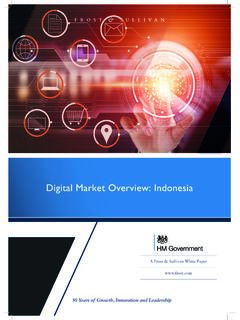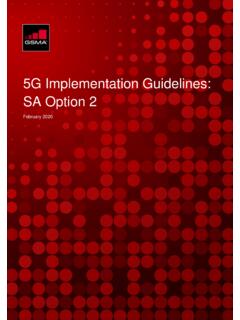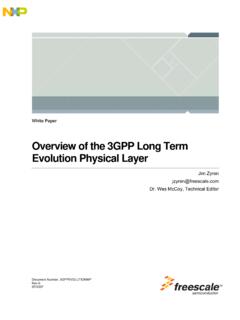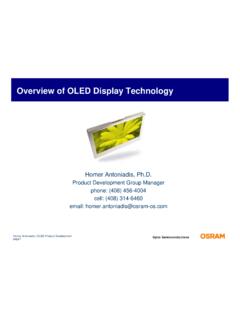Transcription of Future Autonomous Systems Overview
1 Page 1 Autonomy Working Group Thomas Kazior (Raytheon) and Daniel Lee (UPenn), co-leads 31 August 2016 Future Autonomous Systems Overview Page 2 Autonomous Systems Working Group Charter n Autonomous Systems are here today. How do we envision Autonomous Systems of the Future ? n Our purpose is to explore the what ifs of Future Autonomous Systems . 10+ years from now what are the emerging applications / Autonomous platform of interest? What are common needs/requirements across different Autonomous platforms? What advances in materials, devices, sensors, computation and communication technologies, architecture, algorithms, security/trust are required to realize these Future Autonomous Systems ? What research/develop to we need to start today to enable this Future vision? n Note: Focus on technology (not policy or ethical/moral issues) Page 3 Members Tom Kazior Raytheon Dan Lee Penn Naresh Shanbhag UIUC CY Sung Lockheed Ralph Etienne-Cummins Johns Hopkins Mei Chen SUNY Albany Ed Rietman UMass Philip Wong Stanford Dan Radack IDA Page 4 Autonomy and Intelligent Systems n Description: Systems that are aware and interact with their environment.
2 DARPA defines intelligent Systems as " Systems that know what they're doing" and exhibit the following abilities: will be able to infer and reason, using substantial amounts of appropriately represented knowledge will learn from their experiences and improve their performance over time will be capable of explaining themselves and taking naturally expressed direction from humans will be aware of themselves and able to reflect on their own behavior will be able to respond robustly to surprises and explore in a very general way will be able to interact/interface with humans, if in the loop, using the same language as the human nervous system n Attributes of Autonomy and Intelligent Systems include, but not limited to: Energy efficiency (esp. for untethered and energy constrained Systems ) Decision Making l Perception and awareness, Recognition, Learning, Planning, Knowledge representation, Reasoning Speed/Latency Trust Minimum number of sensors What research is required today to enable Future Autonomous Systems with these characteristics?
3 Page 5 Future Autonomous Systems n Missions Replace humans (in certain tasks) l Unattended exploration ( , space, undersea, hazardous environment) l Unattended monitoring (situational awareness) Assist humans l Overcome handicaps l Repetitive tasks l Requires robust human-machine interface Augment/Enhance human capabilities l Requires robust human-machine interface n Inspiration Biology/nature inspired (biological organisms) Science fiction inspired l Example: book called Lock In: Humans have robots that interact for them Page 6 Types of Autonomous Systems n UXVs Unmanned X Vehicles where X = undersea (UUVs), on sea, on land (driverless cars), in air (UAV), in space l Emphasis on mobility in various environments l Need for energy efficient locomotion and navigation n Robots perception, planning and decision making mobile manipulation enhance human capabilities Page 7 Autonomous Systems Swarms n Swarms: Collection of Autonomous Systems with distributed communication and control Biological inspiration from ant colonies and bird flocking behaviors Human teams and organizations need good communication and decision making capabilities Advantage of robot teams.
4 Efficient convoying and V2V, faster search and rescue operations, wider ISR coverage n Distributed computing and communications between individual agents and high-level human control n Robustness: adaptation, learning, and reconfigurability n How to make whole greater than sum of parts? Page 8 Future Autonomous system Desire-ments (1) n Enhanced Situational Awareness Intelligent (cognitive), Adaptive (Reconfigurable) multi-function/multi-mode sensors l In-sensor processors l Coordinated use of multiple sensor modalities Autonomous Operation and Decision making (ability to recognize and react to different and changing scenarios) Supports operation in cluttered/contested/denied environments n Energy efficient communications/networking Supports collaboration of Autonomous Systems and human- Autonomous Systems collaboration n Energy Efficient, Intelligent Processors Scalable, reconfigurable processing (information extraction) architecture Distributed sensor/compute/actuation networks Real-time embedded machine learning Cognitive including advanced neural (and related)
5 Computing Future Autonomous Systems : Energy Efficient, Cost Effective Sensing, Information Extraction and Actuation Page 9 Future Autonomous system Desire-ments (2) n Seamless, natural Human-Machine Interfaces (HMI) n Security ( system , Hardware, Cyber, Processing) n Algorithms Advanced Reasoners: l A capability to choose the best algorithms for the mission including low-power learning, reasoning, and decision making. Adaptive Sensor Resource Management l Algorithms for efficient utilization of multiple sensors and effectors. Adaptive Mission Management l Capability to plan, task and adapt across Systems during mission execution. n Lower C-SWAP (Cost, Size, Weight and Power) Energy efficient circuits/algorithm/architectures/cogniti ve processing Higher levels of integration (functional density) Critical for size and energy constrained platforms Future Autonomous Systems : Energy Efficient, Cost Effective Sensing, Information Extraction and Actuation Page 10 Questions to Consider: n How to characterize levels of autonomy?
6 Quantify intelligent characteristics and behavior n How to compare with human performance? Divide responsibility between humans and machines Ability to override and switch control n What are fundamental limits to autonomy? Energy limits: (decisions/unit of energy)? Tradeoff between functionality and power Robustness versus energy n What is proper balance between autonomy, safety and security? Is it possible to make guarantees for verification and validation n How to plan technology roadmap for Autonomous Systems ? Mapping application level requirements with nanotechnology development Page 11 Enabling Technologies (Computing) n Recent Advances in Machine Learning Deep learning and convolutional neural networks Reinforcement learning (AlphaGo) n Event-Based Computation New sensors and computing paradigms based upon temporal events (spikes).
7 Using time to encode information rather than levels or multiple bits. n Probabilistic Algorithms and Programming Bayesian inference in hardware Exploiting noise and variability in computation n Neuromorphic Computing How to use limited precision and analog hardware Mimic SWAP benefits of biological computation in silicon and other computing fabrics Page 12 Nanotechnology Foundation n Nano-materials and Devices New materials/devices including topological materials Alternate- and multi-state variables/devices Bio-inspired and soft materials/ electronics n Integration Multi-material stacking Advanced Interconnects/connectivity (Local, semi-global and global: Wired and wireless) Thermal solutions n Nanofunctions/Nanofabrics Need to define basic building blocks to support: Stochastic/Statistical Information processing Real-time neuromorphic processing Reconfigurable Circuits/Sensors New Circuits/ Systems for augmenting situational awareness New Circuits/ Systems for enhancing human machine interface Need to explore new materials, device and circuit concepts/ architectures that address desire-ments and enable next generation Autonomous Systems Page 13 Backup Page 14 Common Requirements n Energy efficient computing (or information extraction) and communication n Size and weight n Safety, Privacy, Security n Nanotechnology can have tremendous impact on Autonomous Systems Reduce size, weight, power Page 15 Autonomous Systems enhancing human capability- examples.
8 1) Human being walking around and they have Systems that help them better navigate an environment. What is needed for Autonomous Systems to replicate human in above capabilities Seamless integration between robot/PDA and human. Enough autonomy on these Systems that they could take over certain situations or run independently 2) Book: Locked In virus attacks that causes humans to not be able interact. Humans have robots that interact for You could imagine this applied to people with real illness that prohibit mobility Sounds more like human-machine interface 3) One of the challenges of bio-inspired computing is that it cannot reach the same accuracy as traditional computing Could machines eventually do human computational tasks? Studies on human intelligence? Recent Alpha Go beating world champ in the game of go.
9 Much more complicated than chess What level of on-board intelligence is required? 4) One can trust a machine to aggregate date. One can not trust a human to take tons of data and aggregate by hand. Need to find the right match between human and machine Balance between human s native ability to process information and the kinds of information humans can process vs. what machines can process Page 16 What is being done today (in DoD)? n ONR LOCUST (Low-Cost UAV Swarming Technology) program uses drones, that can be controlled via a line-of-sight radio link or operate autonomously according to a predetermined path. n ONR CARACaS (Control Architecture for Robotic Agent Command and Sensing) - a swarming system that employs multiple unmanned boats working together to escort ships, patrol harbors or confront adversaries. Autonomous swarming capability combines artificial intelligence, machine perception and distributed data n DARPA CODE (Collaborative Operations in Denied Environment program seeks to make improvements in collaborative autonomy In which multiple UAS can work together under the direction of one operator.
10 One advanced function under collaborative autonomy is the identification and engagement of targets with limited supervision from operators new algorithms and software n DARPA ALIAS (Aircrew Labor In-Cockpit Automation system ) The objective of DARPA s ALIAS program is to develop and insert new levels of automation into existing military and commercial aircraft to enable those aircraft to operate with reduced onboard crew. ALIAS seeks to leverage advances in autonomy that reduce pilot workload, augment mission performance, and improve aircraft safety and reliability n DARPA UPSIDE and NEOVISION: Beyond CMOS computation platforms. Using statistical computing and brain inspired architectures as a means to leap-frog over the current limitation of von Neumann based, CMOS computation platforms. Gaining comparable performance while operating at 3 orders of magnitude improvement in power efficiency.










